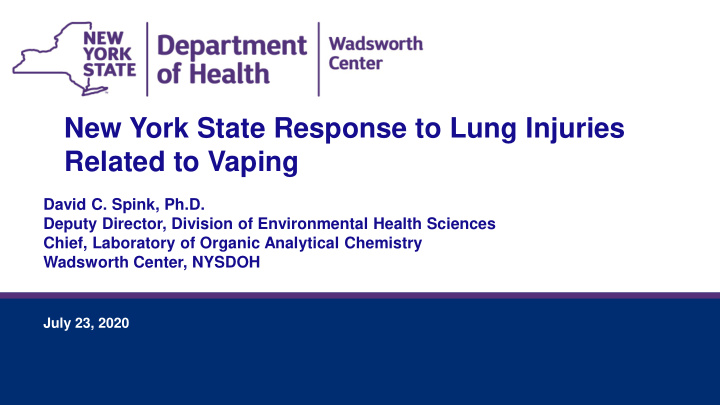



New York State Response to Lung Injuries Related to Vaping David C. Spink, Ph.D. Deputy Director, Division of Environmental Health Sciences Chief, Laboratory of Organic Analytical Chemistry Wadsworth Center, NYSDOH July 23, 2020
July 23, 2020 2 Beginning in of June of 2019, there was a marked increase in reported cases of serious pulmonary injury associated with vaping. The condition, now referred to as e- cigarette or vaping product use- Vaping samples received and associated lung injury (EVALI) , does analyzed at Wadsworth not appear to involve an infectious agent. A chemical adulterant or contaminant in the vaping products is suspected.
July 23, 2020 3 The Laboratory of Organic Analytical Chemistry (LOAC) of Wadsworth houses the New York State Medi dical Mar arijua uana na Labor borat ator ory and supports Poison Control Centers in New York, making it well positioned to contribute to the investigation through the analysis of vaping fluids associated with EVALI cases. LOAC began receiving and analyzing vaping fluids in August of 2019.
July 23, 2020 4 Having no a priori information of prediction of what contaminants or adulterants might be present in the fluids, the Department employed untargeted analyses in the same manner that we use in identifying unknown and suspicious materials, such as white powders, employing: Gas chromatography-mass spectrometry GC-MS) Liquid chromatography-high-resolution tandem mass spectrometry LC-HR-MS/MS (triple-TOF and Q-Exactive Orbitrap)
July 23, 2020 5 Untargeted GC-MS analysis Identifies Vitamin E Acetate in Vaping Fluids Δ 9 - tetrahydrocannabinol (Δ 9 -THC) Vitamin E acetate (VEA; α -tocopheryl acetate)
July 23, 2020 6 EI-mass spectrum of VEA in vaping fluid (above) and NIST library spectrum (below)
July 23, 2020 7 Some cartridges contained medium-chain triglyceride (MCT) oil, others contained VEA oil and some contained both oils.
July 23, 2020 8 Why Δ 8 -THC? The vaporizer fluid shown in panel A displays a typical cannabinoid profile with high Δ 9 -THC, whereas the vaporizer fluid shown in panel B shows the unusual predominance of the Δ 8 -THC isomer.
July 23, 2020 9 So where did the VEA come from? Why was it in the vaporizer fluids? The Department became aware of the internet lore and an on-line cannabis diluent industry, with numerous cannabis oil diluents available for purchase For drug dealers to maximize profits and extend supply, “cutting” the product with cheaper material that is undetectable to the consumer has long been a practice in the illegal market for drugs such as heroin and cocaine.
July 23, 2020 10 Since the firms marketing cannabis oil diluents and thickeners do not list their ingredients on the labels or on their websites, the Department obtained six diluent and thickener products and analyzed them. Some of the diluents and thickeners that were available on-line
July 23, 2020 11 Paraphernalia that comes with your purchase of a diluent
July 23, 2020 12 Three of the products were found to be essentially pure vitamin E acetate
July 23, 2020 13 VEA-based diluents were touted as tasteless and odorless thickeners that are miscible with cannabis oil in all proportions and produce a desirable cloud on vaping. Upon visual inspection, it is nearly impossible to distinguish between a cartridge containing high-grade cannabis oil and one heavily cut with VEA. A vaporizer cartridge found to contain VEA
July 23, 2020 14 Next Gener nerat ation on Diluent uents and d Thickener ners? Two other products were found to be primarily squalane
July 23, 2020 15 Another product is primarily α -bisabolol
July 23, 2020 16 VEA and EVALI? Our studies show a strong correlation between EVALI and the use of at least one cannabis vaporizer cartridge containing VEA. Currently, the cause of EVALI is unknown, nor is it entirely clear what type of vaping products ( i.e ., cannabis or nicotine) are definitively associated with the disease. Beginning in the Spring of 2019, there was a sharp increase in EVALI, with some cases showing clinical presentation consistent with lipoid pneumonia. Other clinical findings are not suggestive of lipoid pneumonia, but rather a chemical burn.
July 23, 2020 17 Compounds that are associated with lipoid pneumonia: Mineral oil Squalene Vaseline Olive oil Sunflower oil Omega-3-acid esters Rendered animal fat Amiodarone Liquid paraffin
July 23, 2020 18 Given that VEA has similar chemical and physical properties (logP oct/water >6 and boiling point >200 °C at 760 mmHg) to compounds such as white mineral oil that are known cause lipoid pneumonia, it is possible that VEA is causative or contributes to the development of lipoid pneumonia.
July 23, 2020 19 Conclusions: The illicit vaporizer fluids associated with VAPI cases can be characterized as: • low in THC content sometimes with an unusual ratio of the Δ 9 - and Δ 8 -THC isomers • • some showing low-level pesticide residues • heavily cut with diluents, most notably VEA There is no evidence that vaping large quantities of compounds such as VEA is safe for human health.
July 23, 2020 20 Pictured above from left to right: Deepika Panawennage, Mark Dittmar, Emily Delaney-Baldwin, Lorie Durocher, Robert Acosta, Commissioner Zucker, David Spink, Shijun "Jimmy" Lu, Lingyun Li and Bryan Duffy.
Recommend
More recommend